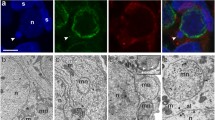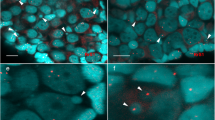Summary
Genetically marked maroon-like (mal) clones were induced by mitotic recombination with X-rays at the blastoderm stage in mal/mal + heterozygotes and were analysed in differentiated Malpighian tubules (MT). Marked cells were not confined to single anterior (MA) or posterior (MP) tubules, but were distributed among the four tubules. About 70% of the clones with two or more cells were fragmented, i.e. mal cells were separated by wild-type cells. Since the clones contain, on average, 6 cells and the differentiated MT consist of 484 cells (2 × 136 MA cells, 2 × 106 MP cells), we estimate that there are about 80 cells in the blastoderm anlage which on average pass through two to three mitoses. With increasing radiation doses (254 R, 635 R, 1270 R) a linear increase in clone frequency is observed. The mean sizes and size distributions of clones, however, remain unchanged. Since the increasing radiation dose also results in fewer differentiated Malpighi cells, we assume that regeneration does not occur. Therefore, size distributions of marked clones presumably represent real mitotic patterns in normogenesis. We suggest that essentially three successive mitoses take place, with a decreasing fraction of cells showing mitotic activity. Only a small fraction of cells goes through a fourth or even a fifth mitosis. Marked non-Minute clones induced in Minute heterozygotes are more frequent, but are not larger than non-Minute clones in wild-type background. Therefore, compartment boundaries cannot be recognized by this method. However, frequencies of marked cells found simultaneously in MA and MP pairs or in several single tubules of the same individuals are significantly higher than frequencies of multiple recombination events predicted by the Poisson distribution. From this, we conclude that neither the MA pair nor the MP pair nor single tubules represent compartments of the MT anlage.
Similar content being viewed by others
References
Altmann J (1966) Die Variabilität der Kernzahlen in den larvalen Speicheldrüsen von Drosophila melanogaster. Z Zellforschung 70:36–53
Becker HJ (1957) Über Röntgenmosaikflecken und Defektmutationen am Auge von Drosophila und die Entwicklungsphysiologie des Auges. Z Induk Abstamm Vererbungsl 88:333–373
Becker HJ (1976) Mitotic recombination. In: Ashburner M, Novitski E (eds) The genetics and biology of Drosophila, vol. 1 c. Academic Press, London, pp 1019–1087
Bodenstein D (1950) The postembryonic development of Drosophila. In: Demerec M (ed) Biology of Drosophila. Hafner Publishing Company, NewYork, pp 275–367
Breugel FMA van, Grond C (1980) Bristle patterns and clones along a compartment border in the anterior wing margin of Drosophila hydei. Wilhelm Roux's Arch 188:195–200
Crick FHC, Lawrence PA (1975) Compartments and polyclones in insect development. Science 189:340–347
Dübendorfer K, Nöthiger R (1982) A clonal analysis of cell lineage and growth in the male and female genital disc of Drosophila melanogaster. Wilhelm Roux's Arch 191:42–55
Ferrus A (1975) Parameters of mitotic recombination in Minute mutants of Drosophila melanogaster. Genetics 79:589–599
Ferrus A, Garcia-Bellido A (1977) Minute mosaics caused by early chromosome loss. Wilhelm Roux's Arch 183:337–349
Ferrus A, Kankel DR (1981) Cell lineage relationships in Drosophia melanogaster: The relationships of cuticular to internal tissues. Dev Biol 85:485–504
Garcia-Bellido A (1975) Genetic control of wing disc development in Drosophila. In: Cell Patterning, Ciba Found Symp NS 29:161–178
Garcia-Bellido A, Merriam JR (1971a) Genetic analysis of cell heredity in imaginal discs of Drosophila melanogaster. Proc Natl Acad Sci 68:2222–2226
Garcia-Bellido A, Merriam JR (1971b) Parameters of the wing imaginal disc development of Drosophila melanogaster. Dev Biol 24:61–87
Garcia-Bellido A, Ripoll P, Morata G (1973) Developmental compartmentalization of the wing disk of Drosophila. Nature New Biol 245:251–253
Garcia-Bellido A, Ripoll P, Morata G (1976) Developmental compartmentalization in the dorsal mesothoracic disc of Drosophila. Dev Biol 48:132–147
Hartenstein V, Campos-Ortega JA (1985) Fate-mapping in wild-type Drosophila melanogaster. I. The spatio-temporal pattern of embryonic cell divisions. Roux's Arch Dev Biol 194:181–195
Hartenstein V, Technau GM, Campos-Ortega JA (1985) Fate-mapping in wild-type Drosophila melanogaster III. A fate map of the blastoderm. Roux's Arch Dev Biol 194:213–216
Haynie JL, Bryant PJ (1977) The effects of X-rays on the proliferation dynamics of cells in the imaginal wing disc of Drosophila melanogaster. Wilhelm Roux's Arch 183:85–100
Janning W (1972) Aldehyde oxidase as a cell marker for internal organs in Drosophila melanogaster. Naturwissenschaften 59:516–517
Janning W (1974) Entwicklungsgenetische Untersuchungen an Gynandern von Drosophila melanogaster I. Die inneren Organe der Imago. Wilhelm Roux's Arch 174:313–332
Janning W (1975) Entwicklungsgenetische Untersuchungen an Gynandern von Drosophila melanogaster III. Einige Beobachtungen an larvalen Gynandern. Verh Dtsch Zool Ges 1974:134–138
Janning W (1976) Entwicklungsgenetische Untersuchungen an Gynandern von Drosophila melanogaster IV. Vergleich der morphogenetischen Anlagepläne larvaler und imaginaler Strukturen. Wilhelm Roux's Arch 179:349–372
Janning W, Labhart C, Nöthiger R (1983) Cell lineage restrictions in the genital disc of Drosophila revealed by Minute gynandromorphs. Roux's Arch Dev Biol 192:337–346
Lawrence PA (1973) A clonal analysis of segment development in Oncopeltus (Hemiptera). J Embryol Exp Morphol 30:681–699
Lawrence PA (1982) Cell lineage of the thoracic muscles of Drosophila. Cell 29:493–503
Lawrence PA, Johnston P (1982) Cell lineage of the Drosophila abdomen: the epidermis, oenocytes and ventral muscles. J Embryol Exp Morphol 72:197–208
Lindsley DL, Grell EH (1968) Genetic variations of Drosophila melanogaster. Carnegie Inst Washington Publ 627
Madhavan MM, Schneiderman HA (1977) Histological analysis of the dynamics of growth of imaginal discs and histoblast nests during the larval development of Drosophila melanogaster. Wilhelm Roux's Arch 183:269–305
Nöthiger R (1972) The larval development of imaginal disks. In: Ursprung H, Nöthiger R (eds) Results and problems in cell differentiation, vol. 5. Springer, Berlin Heidelberg New York, pp 1–34
Poulson DF (1950) Histogenesis, organogenesis, and differentiation in the embryo of Drosophila melanogaster Meigen. In: Demerec M (ed) Biology of Drosophila. Hafner Publishing Company, New York, pp 168–274
Schüpbach T, Wieschaus E, Nöthiger R (1978) The embryonic organization of the genital disc studied in genetic mosaics of Drosophila melanogaster. Wilhelm Roux's Arch 185:249–270
Schweizer P (1972) Wirkung von Röntgenstrahlen auf die Entwicklung der männlichen Genitalprimordien von Drosophila melanogaster und Untersuchung von Erholungsvorgängen durch Zellklon-Analyse. Biophysik 8:158–188
Sonnenblick BP (1950) The early embryology of Drosophila melanogaster. In: Demerec M (ed) Biology of Drosophila. Hafner Publishing Company, New York, pp 62–167
Steiner E (1976) Establishment of compartments in the developing leg imaginal discs of Drosophila melanogaster. Wilhelm Roux's Arch 180:9–30
Stern C, Tokunaga C (1971) On cell lethals in Drosophila. Proc Natl Acad Sci 68:329–331
Szabad J, Schüpbach T, Wieschaus E (1979) Cell lineage and development in the larval epidermis of Drosophila melanogaster. Dev Biol 73:256–271
Wessing A, Eichelberg D (1978) Malpighian tubules, rectal papillae and excretion. In: Ashburner M, Wright TRF (eds) The genetics and biology of Drosophila, vol. 2c. Academic Press, London, pp 1–42
Wieschaus E, Gehring W (1976) Clonal analysis of primordial disc cells in the early embryo of Drosophila melanogaster. Dev Biol 50:249–263
Author information
Authors and Affiliations
Additional information
On the occasion of his 60th birthday, this work is dedicated to Prof. Dr. H.J. Becker, who initiated cell lineage studies in Drosophila
Rights and permissions
About this article
Cite this article
Janning, W., Lutz, A. & Wissen, D. Clonal analysis of the blastoderm anlage of the Malpighian tubules in Drosophila melanogaster . Roux's Arch Dev Biol 195, 22–32 (1986). https://doi.org/10.1007/BF00444038
Received:
Accepted:
Issue Date:
DOI: https://doi.org/10.1007/BF00444038




